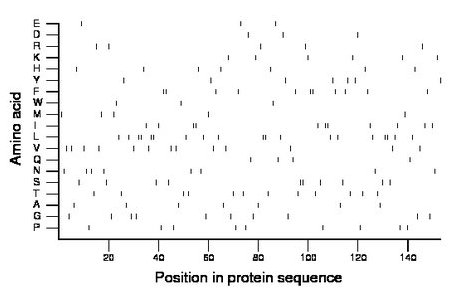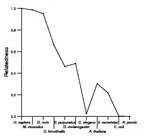
| Name: ORMDL1 | Sequence: fasta or formatted (153aa) | NCBI GI: 7706009 | |
|
Description: ORM1-like 1
|
Referenced in: ER, Golgi, and the Secretory Pathway
| ||
Other entries for this name:
alt mRNA [153aa] ORM1-like 1 | |||
|
Composition:

Amino acid Percentage Count Longest homopolymer A alanine 4.6 7 1 C cysteine 0.0 0 0 D aspartate 2.0 3 1 E glutamate 2.0 3 1 F phenylalanine 7.2 11 2 G glycine 6.5 10 1 H histidine 4.6 7 1 I isoleucine 7.2 11 2 K lysine 3.9 6 1 L leucine 12.4 19 2 M methionine 3.3 5 1 N asparagine 5.2 8 1 P proline 5.9 9 1 Q glutamine 2.6 4 1 R arginine 3.3 5 1 S serine 6.5 10 2 T threonine 7.8 12 1 V valine 8.5 13 1 W tryptophan 2.0 3 1 Y tyrosine 4.6 7 1 |
Comparative genomics:
Search single species RefSeq proteins at NCBI
Search summary 
Figure data | ||
Related human proteins:Protein Relative score Description Self-match 1.000 ORM1-like 1 ORMDL1 1.000 ORM1-like 1 ORMDL3 0.886 ORM1-like 3 ORMDL2 0.869 ORMDL2 HACE1 0.017 HECT domain and ankyrin repeat containing, E3 ubiqu... CCR4 0.017 chemokine (C-C motif) receptor 4 LOC100294145 0.014 PREDICTED: hypothetical protein CUBN 0.010 cubilin MBOAT1 0.010 membrane bound O-acyltransferase domain containing ... HSF2 0.010 heat shock transcription factor 2 isoform a TNIK 0.007 TRAF2 and NCK interacting kinase isoform 8 TNIK 0.007 TRAF2 and NCK interacting kinase isoform 7 TNIK 0.007 TRAF2 and NCK interacting kinase isoform 6 TNIK 0.007 TRAF2 and NCK interacting kinase isoform 5 TNIK 0.007 TRAF2 and NCK interacting kinase isoform 4 TNIK 0.007 TRAF2 and NCK interacting kinase isoform 3 TNIK 0.007 TRAF2 and NCK interacting kinase isoform 2 TNIK 0.007 TRAF2 and NCK interacting kinase isoform 1 LAMA5 0.007 laminin alpha 5Human BLASTP results (used to prepare the table) | |||
Gene descriptions are from NCBI RefSeq. Search results were obtained with NCBI BLAST and RefSeq entries. When identical proteins are present, the self-match may not be listed first in BLASTP output. In such cases, the table above has been reordered to place it first.
See About the Figures for the scoring system used in the figure above right. The same scoring system was used in the table of BLASTP results.
Guide to the Human Genome
Copyright © 2010 by Stewart Scherer. All rights reserved.
